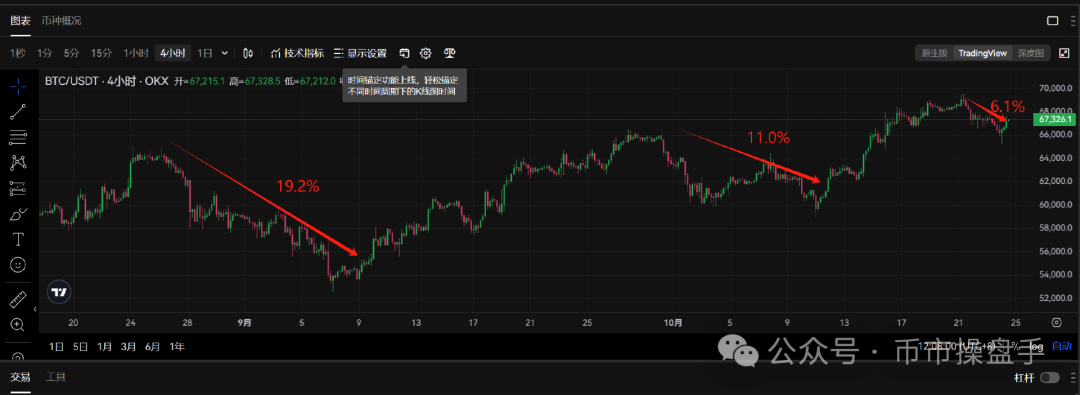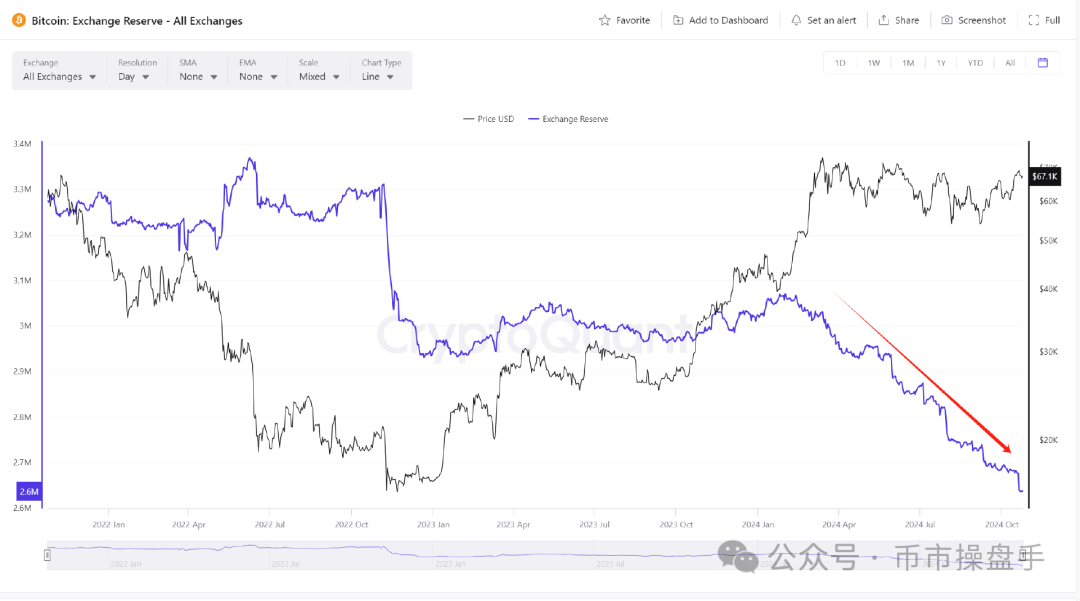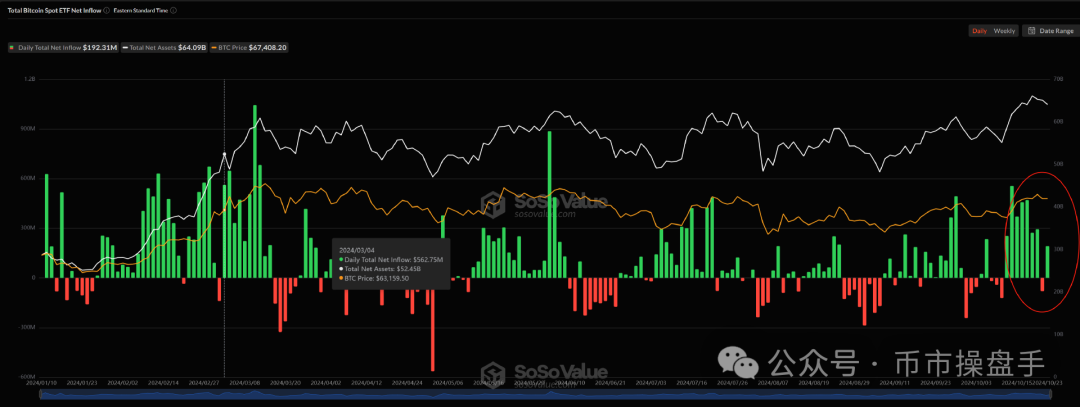Source: Coin Market Operator
After encountering resistance and retreating from the $70,000 mark, Bitcoin has entered a phase of adjustment. Although the market remains tense, the decline in Bitcoin's price during each round of adjustment has gradually converged, as seen in the 4-hour trend. According to data from CrytoQuant, since peaking at $73,000, Bitcoin's exchange balance has shown a rapid downward trend, significantly reducing the supply of chips in the market. At the same time, during Bitcoin's adjustment, funds into the U.S. Bitcoin ETF have been continuously flowing in. This indicates that with limited bearish selling momentum and a strong willingness in the market to buy the dip, aggressive shakeouts may lead to the main players losing their chips. Therefore, they are more inclined to conduct shakeouts through a method of "sideways instead of adjustment." In other words, before breaking through $73,000, the market's adjustment will gradually become milder, with shakeouts more likely to be achieved by wearing down investors' patience.



In the context of a stagnant market, altcoin trends remain primarily differentiated. Active funds continue to concentrate in the MEME and new public chain sectors, while most altcoins continue to oscillate and weaken. After all, the daily trading volume currently remains between $80 billion and $100 billion most of the time, far from the $500 billion average daily level in 2021, and this level of volume cannot support a broad market rally. Moreover, the evolution of past bull markets has been complex and fraught with difficulties, with bull and bear markets intertwined, making it very challenging for most investors to profit passively. For example, in September-October 2020, despite Bitcoin's continuous rise, the DeFi sector entered its darkest moment since its inception, with UNI dropping from $8.6 to $1.7 and SUSHI from $13.4 to $0.4, creating a stark contrast in the market. Even after the desperate decline, the DeFi sector experienced a violent bull market, but many investors failed to withstand the test during that adjustment and ultimately missed the bull market feast.
In summary, there is no absolute value or absolute bubble in the market, nor is there a clear distinction between large-cap and small-cap assets. The outcome of the game in a stagnant market usually leaves most people feeling uncomfortable while a few profit. If the rise of altcoins can achieve this effect, altcoins will rise accordingly. Only in the mid to late stages of a bull market, with continuously increasing trading volume, can a broad market rally become possible. For most investors who are fully invested and missing out, there is one expectation that remains clear: as long as Bitcoin opens up upward valuation space, most altcoins will eventually have the opportunity for a rebound.
Recently, as the ETH/BTC exchange rate fell to a new low since the peak of the 2021 bull market, various bearish comments on Ethereum have begun to proliferate. The bearish viewpoint mainly focuses on two aspects: first, the large-scale expansion of Layer 2 has had a significant "vampiric effect" on the main chain, gradually weakening its core position; second, the rise of high-performance public chains like Solana and SUI is continuously eating into Ethereum's market share, leading it towards decline.
In fact, the development direction of blockchain has always been to continuously reduce costs and increase efficiency while achieving decentralization as much as possible. The prosperity of the Layer 2 ecosystem has allowed Ethereum to significantly enhance its processing capacity and efficiency while maintaining security and decentralization, promoting application diversification to meet the needs of more users. This aligns perfectly with the core values of blockchain and is an inevitable trend of continuous optimization and development.
First, although some of Ethereum's business has shifted to Layer 2, the vast majority of Layer 2 still rely on Layer 1 as a data availability layer. As the activity of Layer 2 transactions continues to increase, the frequency and scale of data being sent back to Layer 1 also increase, leading to greater consumption of Ethereum GAS.
Second, the growth of Layer 2 networks has significantly increased the demand for Layer 1 bridging and staking. For example, in cross-chain processes, asset locking (smart contracts) requires the consumption of Ethereum GAS, while ETH, as the most important value medium in the network, is also widely used for economic guarantees in cross-chain mainnet verification. Additionally, some bridging protocols will also record transaction data on Ethereum to ensure that the quantity and status of asset transfers meet expectations, which will also consume Ethereum GAS.
Even if some Layer 2s adopt third-party data availability layers like Celestia to reduce costs, or change the GAS of Layer 2 networks from ETH to governance tokens to increase the demand for governance tokens, all transactions still need to be settled on the Ethereum mainnet. As long as issues of asset and transaction security are involved, Ethereum cannot be bypassed.
In the Layer 2 era, Ethereum plays more of a role as a decentralized "central clearing bank," responsible for the security and effectiveness of all transactions in the ecosystem. As the scale of the Layer 2 ecosystem continues to grow, Ethereum's network effect will see unprecedented enhancement, and the demand for Ethereum collateral and Ethereum GAS will explode. The current sluggishness in coin prices is still a reflection of the overall low demand in the network; as long as new application breakthroughs are found, all difficulties will be resolved.
Although the rise of high-performance public chains like Solana and SUI has indeed eaten into some of Ethereum's market share, in the POS field, Ethereum remains an unshakable leader, mainly reflected in two aspects: first, thanks to the developed Layer 2 ecosystem, Ethereum has achieved scalability while maintaining a high degree of decentralization. In contrast, other public chains generally enhance scalability by sacrificing decentralization, which also leads to their network security falling far short of Ethereum's level; second, in terms of ecological development, Ethereum's advantages remain far ahead. According to the latest data from Defillama, the current TVL of the Ethereum ecosystem (including Layer 2) is $72 billion, with a stablecoin scale of $83.6 billion. In contrast, the Solana ecosystem, often referred to as the "Ethereum killer," has a total TVL of only $7 billion (with MEME coins accounting for over 40%), and a stablecoin scale of only $3.7 billion. The gap is almost a chasm.
For assets with clearly cyclical demand, a counter-cyclical trading strategy is often the best operational approach. The specific method is to buy when Ethereum's price-to-earnings ratio (total market value/GAS income) and price-to-sales ratio (total market value/total on-chain transaction volume) reach their peaks, and sell when these ratios are at their lowest. Therefore, the prolonged low activity in Ethereum's network currently indicates that a phase of buying opportunity has emerged.
免责声明:本文章仅代表作者个人观点,不代表本平台的立场和观点。本文章仅供信息分享,不构成对任何人的任何投资建议。用户与作者之间的任何争议,与本平台无关。如网页中刊载的文章或图片涉及侵权,请提供相关的权利证明和身份证明发送邮件到support@aicoin.com,本平台相关工作人员将会进行核查。




